Photo / Video News & Reviews
Subscapes
Landscape photography has remained a popular art form since the birth of the art of “painting with light”. Many photographers simply record views of landscapes seen while on holiday, others go to extremes to capture the right view, in the right light, at the right time of year, whatever “right” means to the location and the photographer.
Many years ago, I met one such photographer who had waited five years to capture one particular landscape, full of daffodils, within one hour of dawn, within a very short calendar period, having been rained off for the first four attempts. Such dedication is to be admired of course, but few of us have it.
The basic rules for landscape can be summarized as follows:
Select the film/digital media appropriate to the required result (projection, printing, large area printing, etc.).
Use a good quality metering system, whether in the camera or external to it, and consider bracketing.
Select a lens of suitable focal length for the proposed view.
Use a tripod to remove camera-shake, as you may be using slow shutter speeds to gain high aperture settings.
Finally, ensure that the sharpest focus point is near the camera, as this reproduces the human eye view, where distant points are less sharp. Something of interest in the foreground makes all the difference to a landscape view. To confirm this – spend a day in an art gallery viewing the works of Turner, Friedrich, and Constable.
Some years ago, I took up SCUBA diving and having enjoyed landscape photography I noted that the vast majority of underwater images in the public view at that time were of brightly coloured fish, often in exotic seas, many of the shots being flash lit.
An obvious challenge was to capture larger areas, “underwater landscapes”, and to capture them in the often less-than-perfect conditions around the UK. Like so many aspects of diver training, if you can handle the UK conditions, you are likely to handle overseas destinations relatively easily.
The rules for subscape and landscape photography are the same. The desire for a large depth of field requires high f-stop settings, even with a wide-angle lens, and thus a slower than may be wished for shutter speed. The risk of camera shake then arises. On land, the tripod is the obvious solution and few good landscapes are shot by purely hand-held cameras. Many photographers will place the camera against a wall, a tree trunk, or rock, when a tripod cannot be accommodated.
Underwater there are similar possibilities, and certainly on a wreck site there may be perfect camera rests available. Elsewhere, the problems associated with this idea include disturbing the bottom as you place the camera, immediately creating clouds of particulate in your view, and finding a surface at a reasonable angle for the camera. Why is there never a tall boulder with a flat top when you need one?
Keeping the camera still once you have composed the shot is the first skill to master. Without a support, your buoyancy skills come into critical view – no pun intended. Underwater photographers have a reputation for disturbing the sediment as they kneel on the seabed to enable a steady camera position. Learn to settle gently and to lift off again with the minimum disturbance. Keeping your knees bent, push yourself off the bottom with one hand while taking a deep breath to give you extra lift. As you clear the seabed, breathe out again and fin gently away.
Practice is the only approach, and a readiness to shoot the same view several times. Those of us who started on roll-film cameras appreciate the multi-shot features of digital camera systems. On that subject, I strongly suggest that you set your digital camera to the following four selections:
Shoot RAW images.
Set the largest image size your camera will give you.
Install a large memory card – memory is now very economically priced.
Select an ISO suitable for your location. (No faster than 400ASA/ISO)
If you can set Manual Focus, do so. We are looking for a large depth of field, and using a wide-angle lens, so it is likely that setting your camera to focus at between one and two metres will generate good results.
Auto-focus systems can struggle underwater as they tend to work on contrast within the field of view. In UK waters, this can be very subtle indeed, and there is nothing more frustrating than having set up a shot and having the camera refuse to shoot.
Having accomplished the required basic skills, prepare to review your work critically, prepare to delete more than you save on you home computer. As you progress you will discard fewer images, but I have yet to find any photographer who achieves a one hundred per cent success on any shoot.
At this point, we have yet to add lighting systems to the mix. The equipment available today offers many possible options. Your photographic requirements and budget need to be balanced. You may decide to use wide-angle video lighting with your stills camera, pure strobe lights, or strobes with built-in modelling lights.
One of the main problems in underwater photography, when using artificial lighting, after getting the exposure right, is suspended particulate generating backscatter. You see it when you switch on your torch as the natural light dims, and on so many occasions, you will have realised that it is better to allow your eyes to acclimatize.
Your Subscape will be similarly affected. Positioning the light source(s) is critical. Deciding whether to use them at all depends on your evaluation of the particulate on the day. Can you shoot with available light or not, depending possibly on the practicality of holding the camera steady? Can you find a suitable support for the camera housing? Artificial lighting should only be as “fill” lighting. Most of you will be aware that flash can overpower the whole scene rendering much of it in shadow.
This is not at all acceptable underwater. The ideal is simple, angle the camera upwards toward the daylight at the surface, and use artificial lighting to lift the closest items, which should also be you point of focus. The upward angle is likely to be between 10 and 30 degrees , unless you are shooting an over-hang.
Underwater landscape photography is not for the faint-hearted. Having mastered the skills of SCUBA Diving, and learnt to relax sufficiently to operate other equipment such as still or video cameras, you need to operate efficiently within the environment. In the UK this often means coping with low temperatures, as the best visibility is invariably in the winter months. As with landscape photography, you may return often to the same area seeking the shot that captures the vista completely.
Underwater imaging equipment is available on the market today at prices to suit most budgets. The most expensive items tend to the artificial lighting units, whether strobes of video lights. This may come as a shock to many photographers, when they are asked to spend up to ten times the price of the camera on two flashguns.
My Nikon D5000 in an Aquatica housing remains in use today, nearly ten years on, and with a wide-angle adaptor, it has produced excellent work. A single Sea & Sea strobe completes that set-up.
My main camera is a Nikon D70 fitted with a SIGMA 12~24mm EX lens, in an Aquatica housing, with two Sea & Sea strobes with diffusers.
Blogs
Diver Discovering Whale Skeletons Beneath Ice Judged World’s Best Underwater Photograph
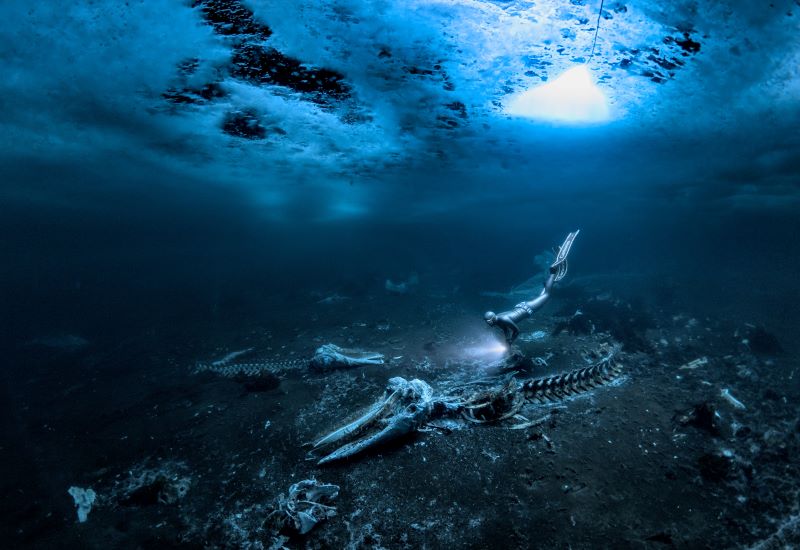
An emotive photograph showing a freediver examining the aftermath of whaling sees
Alex Dawson from Sweden named Underwater Photographer of the Year 2024. Dawson’s
photograph ‘Whale Bones’ triumphed over 6500 underwater pictures entered by underwater
photographers from around the world.
“Whale Bones was photographed in the toughest conditions,” explains chair of judging
panel Alex Mustard, “as a breath-hold diver descends below the Greenland ice sheet to bear
witness to the carcasses. The composition invites us to consider our impact on the great
creatures of this planet. Since the rise of humans, wild animals have declined by 85%. Today,
just 4% of mammals are wildlife, the remaining 96% are humans and our livestock. Our way
needs to change to find a balance with nature.”
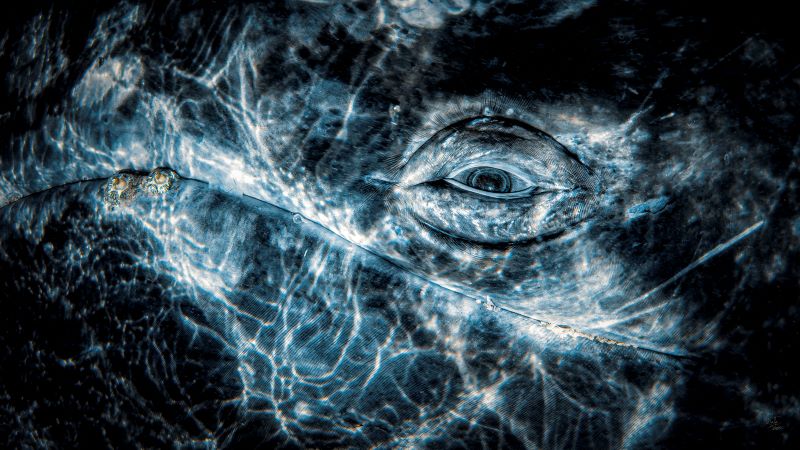
Photo: Rafael
Fernandez Caballero
Whales dominated the winning pictures this year with Spanish photographer Rafael
Fernandez Caballero winning two categories with his revealing photos of these ocean giants:
a close up of a grey whale’s eye and an action shot of a Bryde’s whale engulfing an entire bait
ball, both taken in Magdalena Bay, Baja California, Mexico. Fernandez Caballero took ‘Grey
Whale Connection’ while drifting in a small boat, holding his camera over the side in the water
to photograph the curious whale. ‘The End Of A Baitball’ required Fernandez Caballero to dive
down and be in exactly the right place at the moment the whale lunged. “The photo shows
the high speed attack,” he said, “with the whale engulfing hundreds of kilograms of sardines
in one bite — simply unforgettable to see predation on such a scale.”
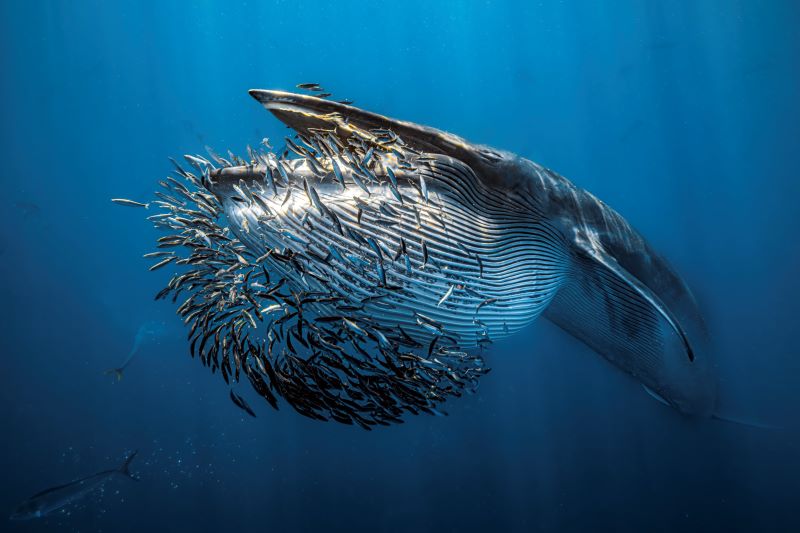
Photo: Rafael
Fernandez Caballero
Lisa Stengel from the United States was named Up & Coming Underwater Photographer of the Year 2024 for her image of a mahi-mahi catching a sardine, in Mexico. Stengel used both a very fast shutter speed and her hearing to catch the moment. “If you listen there’s an enormous amount of sound in the ocean,” she explained. “The action was too fast to see, so I honed in on the sound of the attacks with my camera to capture this special moment.”
“It is such an exciting time in underwater photography because photographers are capturing such amazing new images, by visiting new locations and using the latest cameras,”
commented judge Alex Mustard. “Until this year I’d hardly ever see a photo of a mahi mahi,
now Lisa has photographed one hunting, action that plays out in the blink of an eye.”
The Underwater Photographer of the Year contest is based in the UK, and Jenny Stock,
was named as British Underwater Photographer of the Year 2024 for her image “Star
Attraction”, which finds beauty in species of British wildlife that are often overlooked.
Exploring the west coast of Scotland, Stock explained “in the dark green depths my torch
picked out the vivid colours of a living carpet of thousands of brittle stars, each with a
different pattern. I was happily snapping away, when I spotted this purple sea urchin and I
got really excited.”
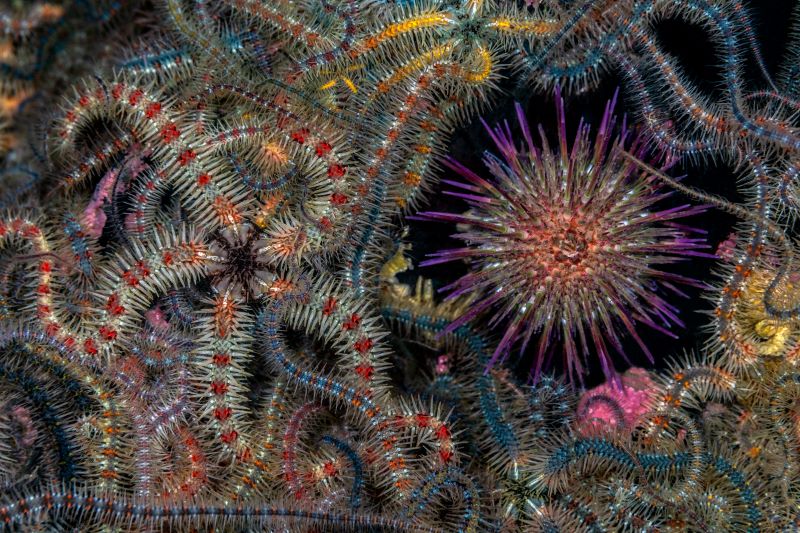
Photo: Jenny Stock
In the same contest, Portuguese photographer, Nuno Sá, was named ‘Save Our Seas
Foundation’ Marine Conservation Photographer of the Year 2024, with his photo ‘Saving
Goliath’, taken in Portugal. Sá’s photo shows beachgoers trying to save a stranded sperm
whale. The picture gives us hope that people do care and want to help the oceans, but also
warns us that bigger changes are needed. “The whale had been struck by a ship and its fate
was sealed,” explains Sá. “An estimated 20,000 whales are killed every year, and many more
injured, after being struck by ships-and few people even realise that it happens.”
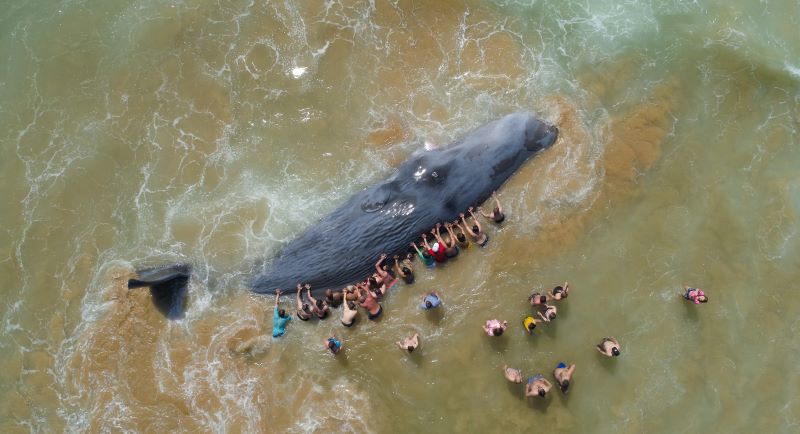
Photo: Nuno Sá
More winning images can be found at www.underwaterphotographeroftheyear.com.
About Underwater Photographer of the Year
Underwater Photographer of the Year is an annual competition, based in the UK, that celebrates photography beneath the surface of the ocean, lakes, rivers and even swimming pools, and attracts entries from all around the world. The contest has 13 categories, testing photographers with themes such as Macro, Wide Angle, Behaviour and Wreck photography, as well as four categories for photos taken specifically in British waters. The winners were announced in an award ceremony in Mayfair, London, hosted by The Crown Estate. This year’s UPY judges were experienced underwater photographers Peter Rowlands, Tobias Friedrich and Dr Alexander Mustard MBE.
Header image: Underwater Photographer of the Year 2024 winner Alex Dawson
News
World’s Best Underwater Photographers Unveil Breathtaking Images at World Shootout 2023
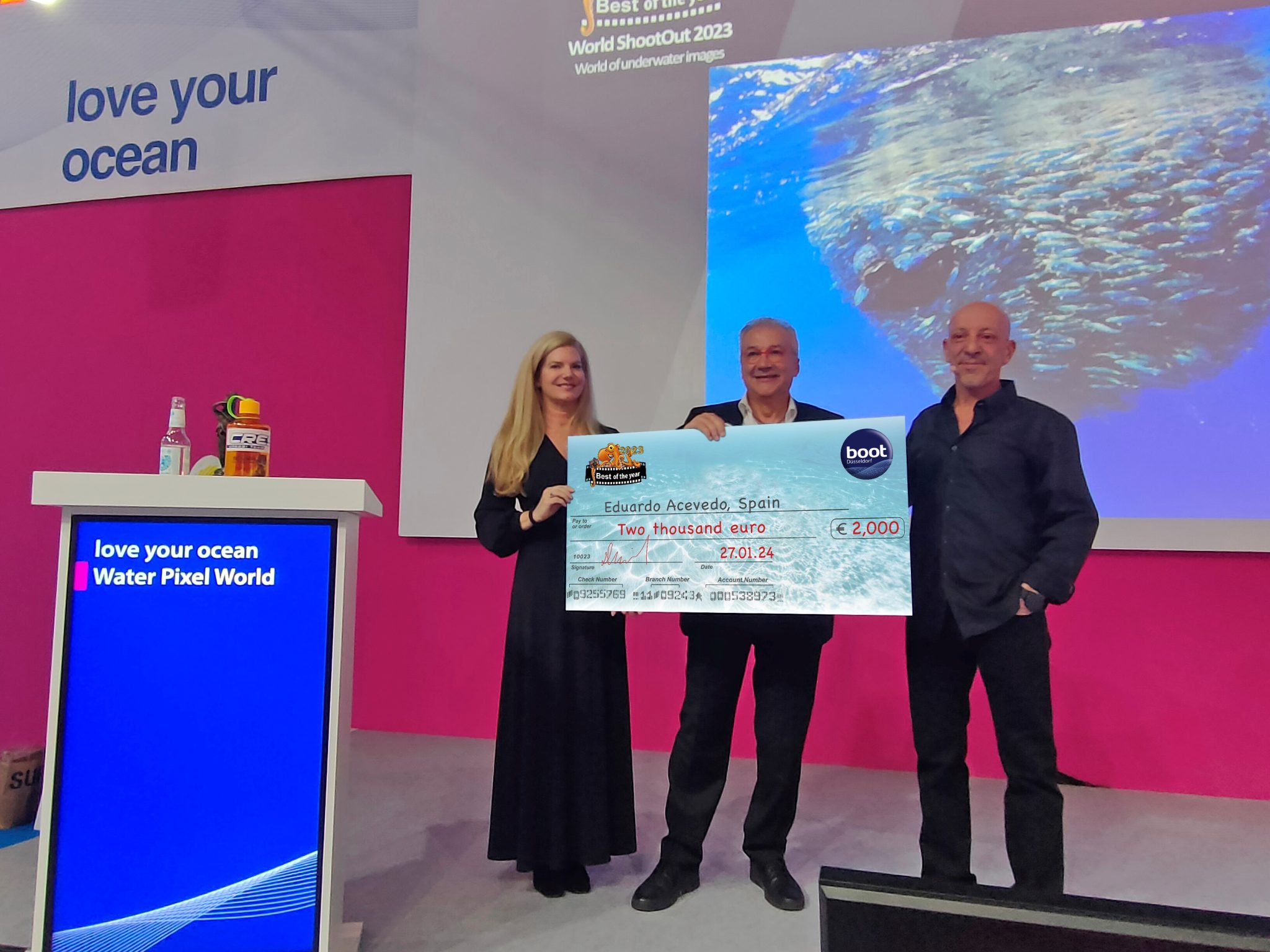
The winners of the prestigious World Shootout 2023 underwater photography competition were announced at this year’s BOOT Show, captivating audiences at the world’s largest diving and water sports exhibition in Dusseldorf, Germany. Hundreds of photographers from 54 countries competed across nine categories, pushing the boundaries of creativity and technical skill.
Grand Prize Winners
- Picture of the Year: Spanish photographer Eduardo Acevedo “secured” the top Honor with the prestigious prize the “boot Dusseldorf Director’s Prize, earning an Andromeda statuette and a €2,000 cash prize.
- Best 5 Images Portfolio: Luc Rooman from Belgium triumphed in this category, winning a dream 4-week diving trip for two to Papua New Guinea, valued at $18,900.
- Amateur Photographer: Alexandra Ceurvorst from the USA impressed the judges with her talent, taking home the 1,000 € cash prize award.
Celebrating Diversity and Innovation
This year’s competition saw 11,680 entries from 964 photographers, showcasing a remarkable spectrum of skills and perspectives. From the intricate wonders of Macro photography to the beauty of “Black Water”, the “Underwater Fashion” category added a touch of artistry and innovation, while the ever-important ” Environmental & Conservation” category served as a powerful reminder of the need to protect these fragile ecosystems.
Looking Ahead: AI and Ocean Conservation
World Shootout founder and producer David Pilosof unveiled an exciting addition for the 2024 competition: this year the Environmental category will be focusing on the impact of plastic on our oceans and future.
This category will embrace the potential of AI or other editing software as a tool to amplify the conservation message.
Entrants will submit campaigns of three original underwater photographs dealing with plastic pollution, along with their final AI assistance processing. This innovative approach encourages artistic expression while raising awareness about a critical environmental issue.
Explore the Stunning Collection
Discover the complete album of competition entries by clicking here.
For Low-resolution photos of finalist entries in eight categories, click here.
-

 News3 months ago
News3 months agoHone your underwater photography skills with Alphamarine Photography at Red Sea Diving Safari in March
-

 News3 months ago
News3 months agoCapturing Critters in Lembeh Underwater Photography Workshop 2024: Event Roundup
-

 Marine Life & Conservation Blogs2 months ago
Marine Life & Conservation Blogs2 months agoCreature Feature: Swell Sharks
-

 Blogs2 months ago
Blogs2 months agoMurex Resorts: Passport to Paradise!
-

 Blogs2 months ago
Blogs2 months agoDiver Discovering Whale Skeletons Beneath Ice Judged World’s Best Underwater Photograph
-

 Marine Life & Conservation2 months ago
Marine Life & Conservation2 months agoSave the Manatee Club launches brand new webcams at Silver Springs State Park, Florida
-

 Gear Reviews3 months ago
Gear Reviews3 months agoGear Review: Oceanic+ Dive Housing for iPhone
-

 Gear Reviews2 weeks ago
Gear Reviews2 weeks agoGEAR REVIEW – Revolutionising Diving Comfort: The Sharkskin T2 Chillproof Suit
















